It’s no wonder that sunflowers have long held the top spot as the most commonly grown cut flower worldwide—they are ridiculously easy to grow, thrive during the dog days of summer and early autumn, bloom abundantly, and require very little attention to thrive.
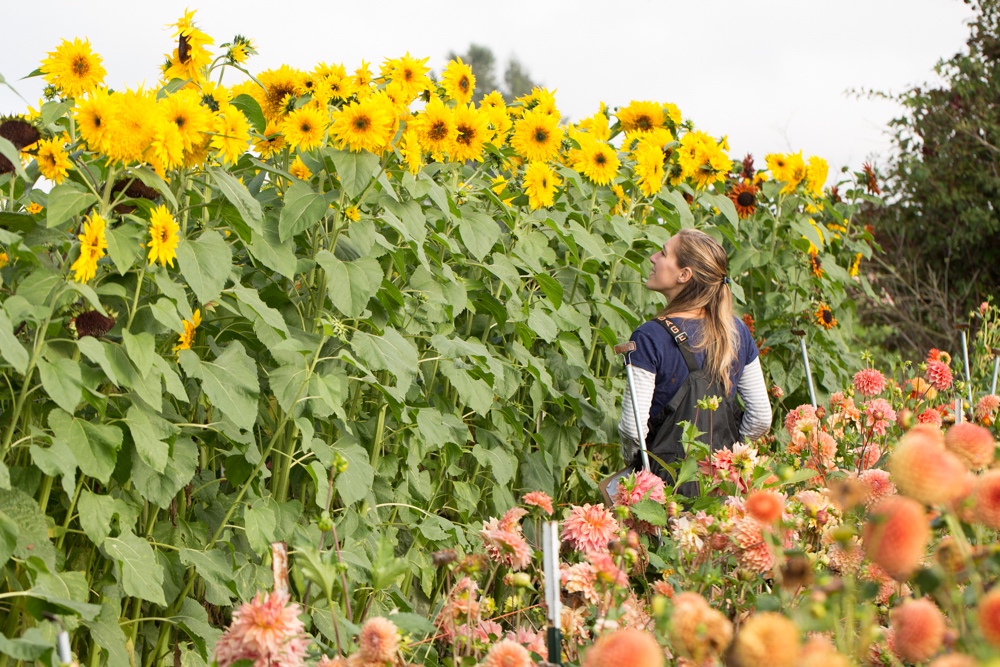 There are two types of sunflowers, branching and nonbranching.
There are two types of sunflowers, branching and nonbranching.
Branching types get quite large and produce an abundance of blooms over a long period of time. They require a good deal of room, so space them 18 to 24 in (45 to 60 cm) apart. To stagger the harvest, sow a new batch every 3 to 4 weeks from spring through midsummer.
Nonbranching types (also called single stem) produce one flower per seed and are prized for their fast bloom time and long, straight stems. These are the types that most flower farmers choose to cultivate.
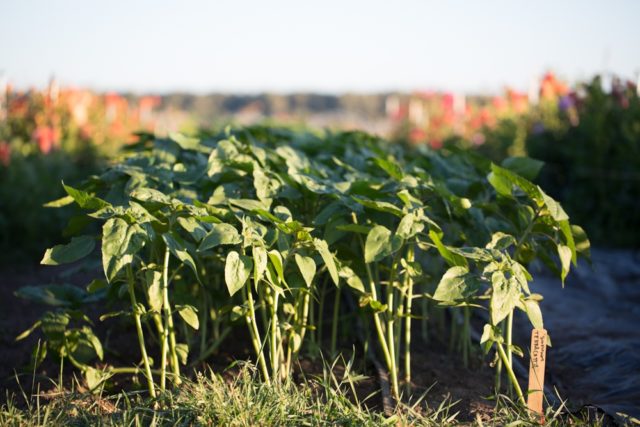 To keep single-stem varieties at a manageable size, it’s best to plant them quite close together, or you’ll end up with broomstick-size stems that are impossible to work into arrangements. For smaller, bouquet-size blooms, space plants 4 to 6 in (10 to 15 cm) apart.
To keep single-stem varieties at a manageable size, it’s best to plant them quite close together, or you’ll end up with broomstick-size stems that are impossible to work into arrangements. For smaller, bouquet-size blooms, space plants 4 to 6 in (10 to 15 cm) apart.
For a continuous harvest, sow successive plantings every 7 to 10 days throughout the spring and early summer.
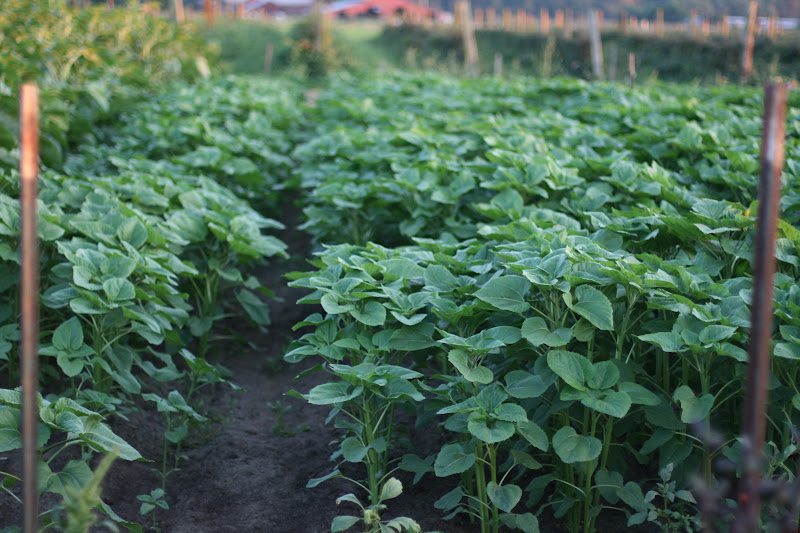 Sunflowers can be either direct-seeded or transplanted into the garden as soon as the weather has warmed and all threat of frost has passed. Seeds germinate rapidly, and within a few days, plants will be poking out of the ground.
Sunflowers can be either direct-seeded or transplanted into the garden as soon as the weather has warmed and all threat of frost has passed. Seeds germinate rapidly, and within a few days, plants will be poking out of the ground.
If birds and other wildlife are an issue, be sure to protect young seedlings until they are 3 to 4 in (7 to 10 cm) tall, since critters will make short work of pulling out young plants and eating the tender seeds if given the chance.
I cover freshly seeded beds with frost cloth and weigh the corners down with heavy stones to keep the birds away until the plants have had a chance to root in and anchor themselves. To avoid this extra step, you can plant out transplants instead of seeds.
 Harvest as soon as the first petals on a sunflower bloom start to unfurl, and strip the bottom three-fourths of the leaves from the stem for the longest vase life. No flower preservative is needed.
Harvest as soon as the first petals on a sunflower bloom start to unfurl, and strip the bottom three-fourths of the leaves from the stem for the longest vase life. No flower preservative is needed.
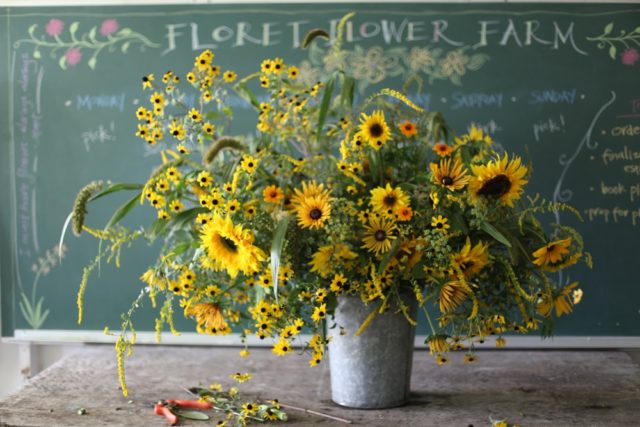 As summer fades and early autumn arrives, sunflowers are at their prime, and there’s no better way to usher in the changing seasons than by creating a wild, textural arrangement filled with the best the garden has to offer.
As summer fades and early autumn arrives, sunflowers are at their prime, and there’s no better way to usher in the changing seasons than by creating a wild, textural arrangement filled with the best the garden has to offer.
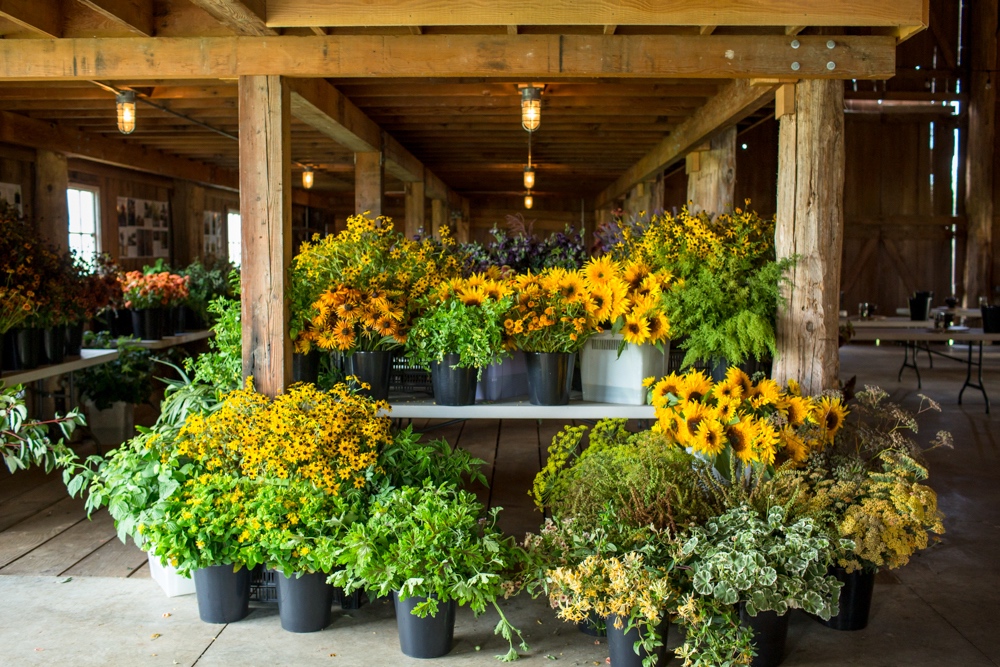
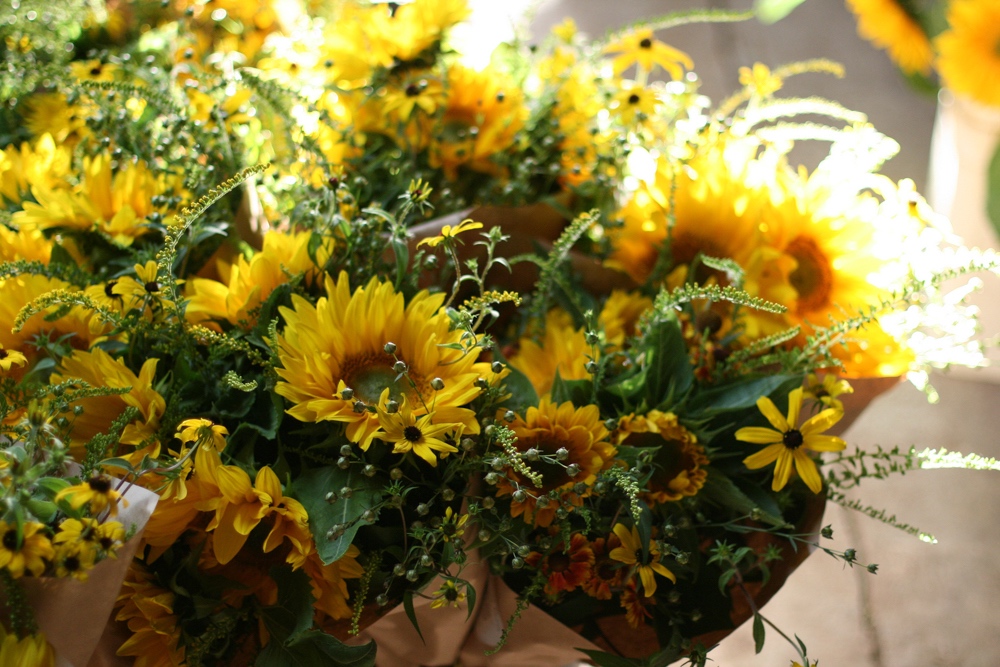 These gorgeous focals combine beautifully with amaranth, millet, and other grains and grasses, as well as rudbeckias (see my post on Grasses, Grains, & Pods). Be sure to mix in some dark-flowered varieties to set off this predominantly green-and-yellow palette.
These gorgeous focals combine beautifully with amaranth, millet, and other grains and grasses, as well as rudbeckias (see my post on Grasses, Grains, & Pods). Be sure to mix in some dark-flowered varieties to set off this predominantly green-and-yellow palette.
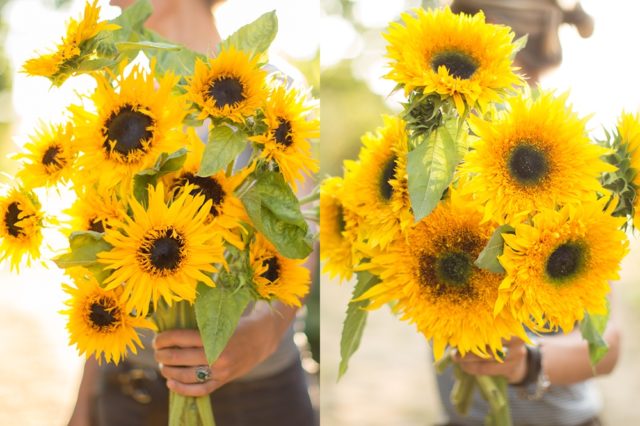 One of the most unique branching varieties we’ve grown, ‘Frilly’ (pictured above, left), is loaded with glowing spiky petals that surround dark fuzzy centers ringed by a delicate fringe. The effect is truly spectacular, and the coloring reminds us of a busy hive of honeybees.
One of the most unique branching varieties we’ve grown, ‘Frilly’ (pictured above, left), is loaded with glowing spiky petals that surround dark fuzzy centers ringed by a delicate fringe. The effect is truly spectacular, and the coloring reminds us of a busy hive of honeybees.
I’ve grown dozens of branching sunflowers over the years, and none has topped ‘Starburst Panache’ (pictured above, right). Its ultra-fluffy, shaggy petals and dark green-brown centers make for a fantastic floral display. These blooms are the epitome of late summer/early autumn and look incredible displayed en masse or mixed with black-eyed Susans and ornamental grasses.
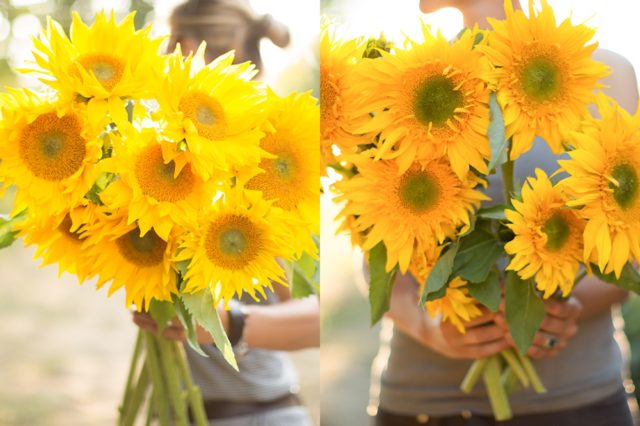 ‘ProCut Gold’ (pictured above, left) is a delightful addition to the cutting garden, featuring light green centers ringed by glowing gold petals. The cheerful blooms mix well with pastels and are perfect for early- to midsummer bouquets. We used to grow more than 10,000 of these each year at the farm for market bouquets. With strong, tall stems, this uniform single-stemmed beauty and the entire ProCut series are bred for commercial cut flower production.
‘ProCut Gold’ (pictured above, left) is a delightful addition to the cutting garden, featuring light green centers ringed by glowing gold petals. The cheerful blooms mix well with pastels and are perfect for early- to midsummer bouquets. We used to grow more than 10,000 of these each year at the farm for market bouquets. With strong, tall stems, this uniform single-stemmed beauty and the entire ProCut series are bred for commercial cut flower production.
The glowing golden semi-double petals of ‘Greenburst’ (pictured above, right) surround a fluffy green center, making for the most beautiful and cheerful display. This extremely productive branching variety is a customer favorite and a must-grow. Flowering just 2 months from seeding, this cutie can be succession-sown from early spring through midsummer for flowers from early summer through late autumn. We grow loads of this variety every year.
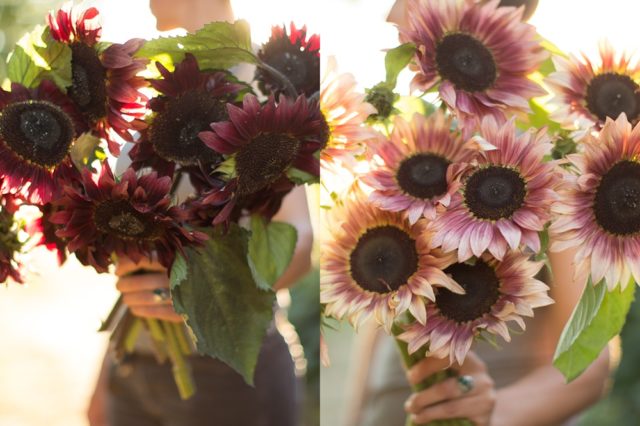 ‘ProCut Red’ (pictured above, left) is a stunning new dark addition. Flowers are a deep, rich rusty red, one of the best dark colors on the market. Dark chocolaty centers gradually give way to ruby-ringed petals that fade to a lighter tip. This reliable single-stemmed variety is pollenless and bred for commercial cut flower production.
‘ProCut Red’ (pictured above, left) is a stunning new dark addition. Flowers are a deep, rich rusty red, one of the best dark colors on the market. Dark chocolaty centers gradually give way to ruby-ringed petals that fade to a lighter tip. This reliable single-stemmed variety is pollenless and bred for commercial cut flower production.
One of the fastest-flowering varieties, ‘Ruby Eclipse’ (pictured above, right) is an attractive branching sunflower that’s as productive as it is beautiful. Blooms are a mix of bicolor flowers in shades of cream, dusty rose, and ruby red. This variety is super easy to grow, and one planting can produce flowers for 3 to 4 weeks. Side branches are the perfect size for bouquets.
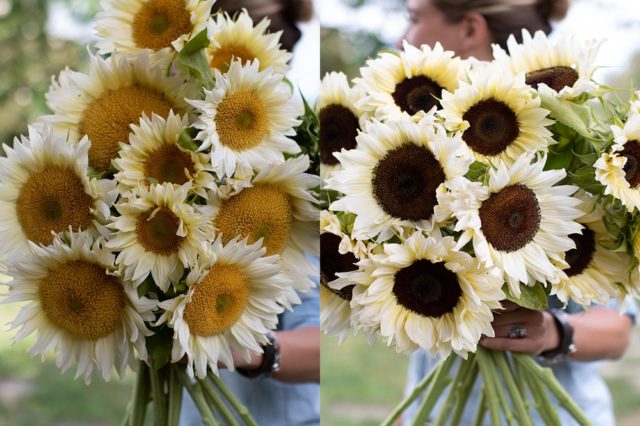 Two additions to the ProCut line produce ivory-petaled flowers: ‘White Lite’ (pictured above, left) with honey-mustard centers and ‘White Nite’ (pictured above, right) with chocolaty-brown centers. Both are single-stemmed varieties.
Two additions to the ProCut line produce ivory-petaled flowers: ‘White Lite’ (pictured above, left) with honey-mustard centers and ‘White Nite’ (pictured above, right) with chocolaty-brown centers. Both are single-stemmed varieties.
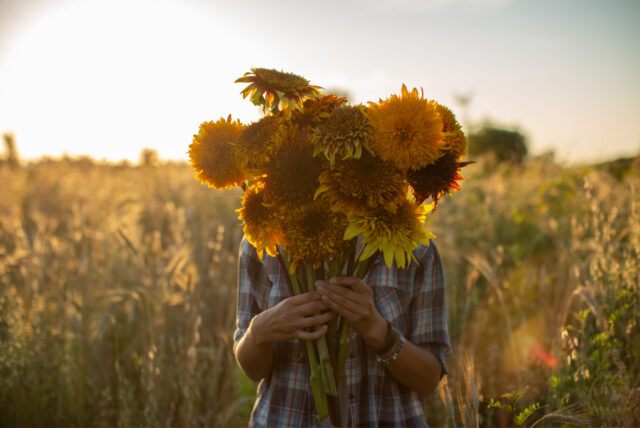 The sunflowers featured above are all more standard, commercially available varieties, and while they make excellent cut flowers, there are a few other standouts worth considering.
The sunflowers featured above are all more standard, commercially available varieties, and while they make excellent cut flowers, there are a few other standouts worth considering.
 Last season we visited Gordon Skagit Farms to see their 6-acre sunflower field in full bloom. I’ve stood in the middle of a lot of giant flower fields and I think this might have been the most beautiful one yet.
Last season we visited Gordon Skagit Farms to see their 6-acre sunflower field in full bloom. I’ve stood in the middle of a lot of giant flower fields and I think this might have been the most beautiful one yet.
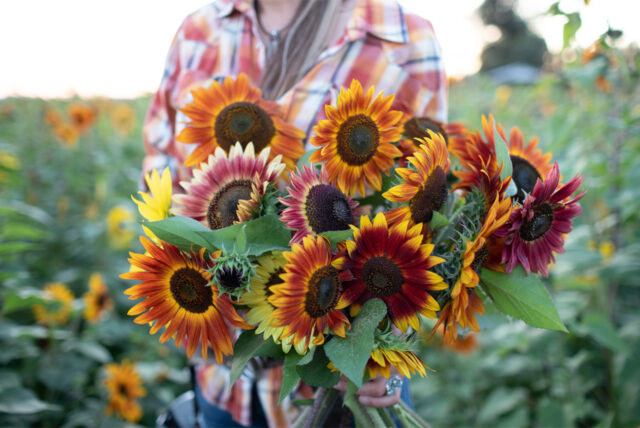 Their field was a branching mix called Autumn Beauty (pictured above). Plants are 7 to 9 ft (2.1 to 2.7 m) tall and come in a beautiful autumn range, including chocolate, burgundy, gold, rust, and maroon. After the flowers fade, plants can be left in the garden to provide food for songbirds in the fall and winter months.
Their field was a branching mix called Autumn Beauty (pictured above). Plants are 7 to 9 ft (2.1 to 2.7 m) tall and come in a beautiful autumn range, including chocolate, burgundy, gold, rust, and maroon. After the flowers fade, plants can be left in the garden to provide food for songbirds in the fall and winter months.
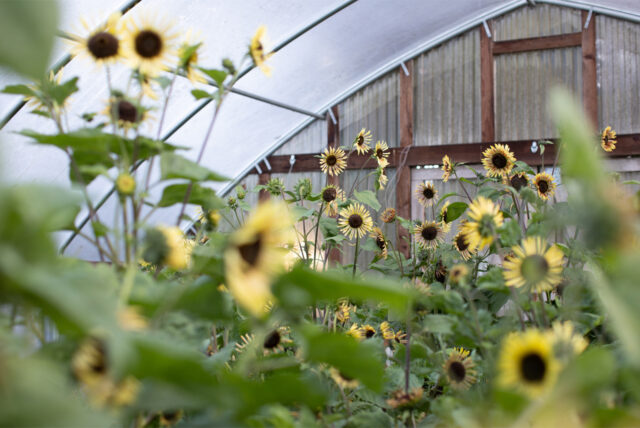 Of all the sunflowers I’ve ever grown, ‘Sparky’ (pictured above and below) is my all-time favorite. This treasure was discontinued years ago and we have worked hard to bring it back. Plants are tall, with outward-facing blooms and a vigorous branching habit ideally suited for flower arranging.
Of all the sunflowers I’ve ever grown, ‘Sparky’ (pictured above and below) is my all-time favorite. This treasure was discontinued years ago and we have worked hard to bring it back. Plants are tall, with outward-facing blooms and a vigorous branching habit ideally suited for flower arranging.
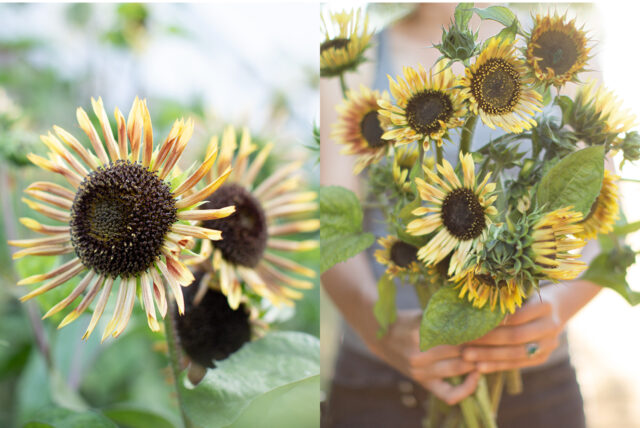
 Flowers have tubular quilled petals and dark chocolate centers in a mix of pale lemon yellow dusted with cocoa and raspberry—coloring similar to that of ‘Sahara’ black-eyed Susans. Plants make great screening and attract birds, especially goldfinches.
Flowers have tubular quilled petals and dark chocolate centers in a mix of pale lemon yellow dusted with cocoa and raspberry—coloring similar to that of ‘Sahara’ black-eyed Susans. Plants make great screening and attract birds, especially goldfinches.
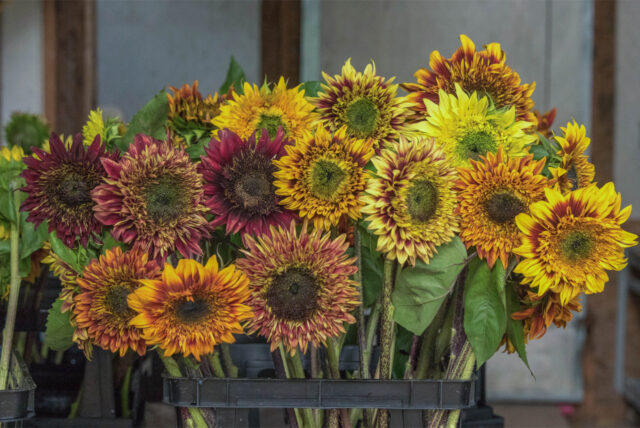 And last but not least, Van Gogh’s Fantasy Mix (pictured above) is a new single-stem teddy bear type bred by Sunflower Steve, a Wisconsin-based flower farmer. This unique mix comes in a warm range of brown, burnt orange, gold, lemon, and plum flowers that range in size from medium to large. You can read a wonderful interview with Steve Kaufer here.
And last but not least, Van Gogh’s Fantasy Mix (pictured above) is a new single-stem teddy bear type bred by Sunflower Steve, a Wisconsin-based flower farmer. This unique mix comes in a warm range of brown, burnt orange, gold, lemon, and plum flowers that range in size from medium to large. You can read a wonderful interview with Steve Kaufer here.
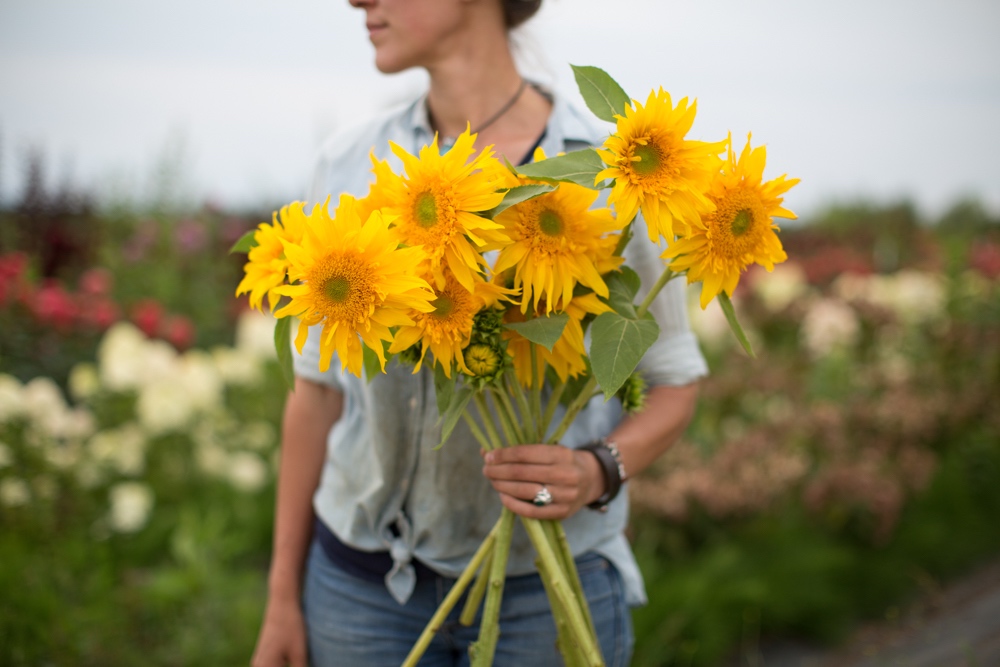
I would love to hear about your experience with sunflowers. Do you grow them or plan to add them to your garden this coming season? If so, what are your favorite varieties?
Please note: If your comment doesn’t show up right away, sit tight; we have a spam filter that requires us to approve comments before they are published.

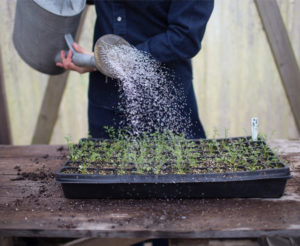
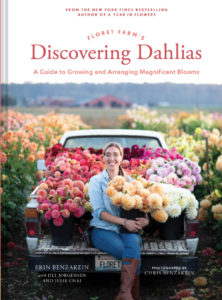
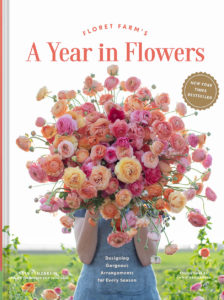
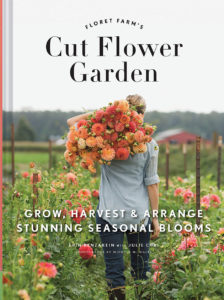

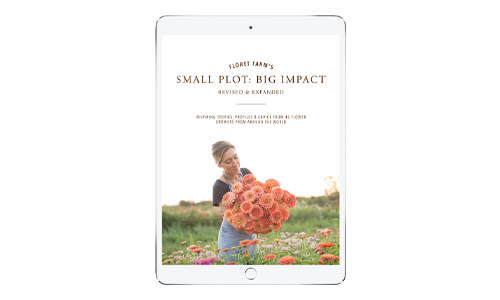
Patty on
I am a home gardener.
Thank you Erin and your team for all of your hard work. The beauty from your endless toil is inspiring. Where do you get your energy?
I have never met a sunflower that I didn’t like :) But, there are two types of sunflowers that bring me the most joy.
The first type is the rogue seed that overwinters in random spots in the garden that sprout in the springtime. These seedlings are always weeks ahead of my own thoughtful plantings. I laugh at myself. They remind me that seeds kind of do their own thing despite my planning and cultivation routines that I take too seriously. I used to pull these babies out when I first started gardening. Now I’ve learned they are one of my favorites to let go and enjoy the show.
The second type of sunflower that I enjoy are the ones that attract birds when going to seed. Bigger sunflower varieties (large single stem seed heads like Mammoth and tall branching varieties like Autumn Beauty) are the best! In late summer/early fall I look forward to the Tufted Titmouse with it’s cute crested cap showing up to dine on these sunflowers. The display is quite entertaining and always puts a smile on my face.
I’m hoping to grow some Frilly this year for cutting bouquets.
Happy New Year!